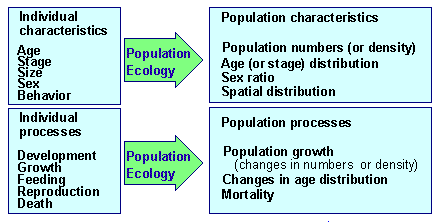1.1. What is Population Ecology?
Population ecology relative to other ecological disciplines

- Population ecology is the branch of ecology that studies the structure and dynamics of populations.
- Physiology studies individual characteristics and individual processes. These are use as a basis for prediction of processes at the population level.
- Community ecology studies the structure and dynamics of animal and plant communities. Population ecology provides modeling tools that can be used for predicting community structure and dynamics.
- Population genetics studies gene frequencies and microevolution in populations. Selective advantages depend on the success of organisms in their survival, reproduction and competition. And these processes are studied in population ecology. Population ecology and population genetics are often considered together and called "population biology". Evolutionary ecology is one of the major topics in population biology.
- Systems ecology is a relatively new ecological discipline which studies interaction of human population with environment. One of the major concepts are optimization of ecosystem exploitation and sustainable ecosystem management.
- Landscape ecology is also a relatively new area in ecology. It studies regional large-scale ecosystems with the aid of computer-based geographic information systems. Population dynamics can be studied at the landscape level, and this is the link between landscape- and population ecology.
- In human demography a population is a set of humans in a given area.
- In genetics a population is a group of interbreeding individuals of the same species, which is isolated from other groups.
- In population ecology a population is a group of individuals of the same species inhabiting the same area.
Populations can be defined at various spatial scales. Local populations can occupy very small habitat patches like a puddle. A set of local populations connected by dispersing individuals is called a metapopulation. Populations can be considered at a scale of regions, islands, continents or seas. Even the entire species can be viewed as a population.
Populations differ in their stability. Some of them are stable for thousands of years. Other populations persist only because of continuous immigration from other areas. On small islands, populations often get extinct, but then these islands can be re-colonized. Finally, there are temporary populations that consist of organisms at a particular stage intheir life cycle. For example, larvae of dragonflies live in the water and form a hemipopulation (term of Beklemishev).
The major problem in population ecology is to derive population characteristics from characteristics of individuals and to derive population processes from the processes in individual organisms:

Main axiom of population ecology: organisms in a population are ecologically equivalent. Ecological equivalency means:
- Organisms undergo the same life-cycle
- Organisms in a particular stage of the life-cycle are involved in the same set of ecological processes
- The rates of these processes (or the probabilities of ecological events) are basically the same if organisms are put into the same environment (however some individual variation may be allowed).


